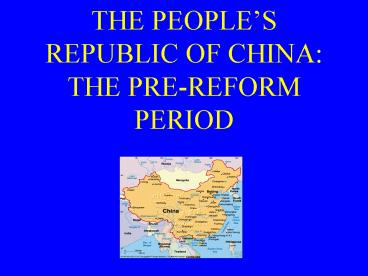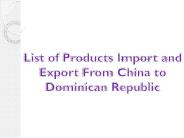THE PEOPLES REPUBLIC OF CHINA: THE PREREFORM PERIOD - PowerPoint PPT Presentation
1 / 25
Title:
THE PEOPLES REPUBLIC OF CHINA: THE PREREFORM PERIOD
Description:
over one billion (1.26 in 2000) Canada's population is 25 million ... Engineered rapprochement with West, especially the US. Richard Nixon's visit. Led by Zhou Enlai ... – PowerPoint PPT presentation
Number of Views:74
Avg rating:3.0/5.0
Title: THE PEOPLES REPUBLIC OF CHINA: THE PREREFORM PERIOD
1
THE PEOPLES REPUBLIC OF CHINATHE PRE-REFORM
PERIOD
2
The Setting
- China is very large (9597K Sq. Km.)
- about the same size as Canada
- Population is huge and growing
- over one billion (1.26 in 2000)
- Canadas population is 25 million
- takes China about 15 months to grow a new Canada!
- this is a major policy problem
3
- Much of its land is uninhabitable or costly to
cultivate - mountains and deserts
- Much of its resource base undeveloped
- e.g., large oil reserves only starting to be
exploited - A poor, developing country
- A rich and very long heritage
4
Chinese Socialism The First Decade
- Mao Zedong proclaims Peoples Republic in October
1949 - Mao takes leadership as chief of state
- Initial tasks
- collectivization of land
- nationalization of industry
5
- Followed typical (Stalinist) planned socialist
model - heavy industry high priority, agriculture low
priority - aggregate investment 20 - 25 of national
product - 85 industrial investment goes to heavy industry
- 8 state investment goes to agriculture
- by end of Mao period, industry share in national
output much higher than other countries at
similar level of development
6
But in the early 1950s, Chinese economy was not
as highly unified and integrated as that of the
Soviet Union. Communications systems were much
less well developed -- Poor flow of information
to center. Poor transportation and the
historically high degree of regional
self-sufficiency meant that gains from
centralizing the economy were much more difficult
to grasp.
7
Much power remained in the hands of
municipalities and provinces, and even the
prefectures and townships. At the height of
planning in China, only 500 commodities fell
under mandatory central control, in contrast to
the more than 30,000 commodities that were part
of the Soviet material balance plans.
8
Collectivization of Agriculture
- First step was redistribution of land from the
landlords to the peasants - Major farming equipment provided by village
authorities - Collectivization involved organizing households
into large production teams - Finally lead to the commune
9
The Rural Peoples Commune
- Created during the Great Leap Forward (1958-1960)
- Individual households organized into production
teams - Production teams combined to form brigades
- Brigades combined into a commune
- thousands of households in a commune
10
- Communes were controlled by the county
- County played major role in implementing the
plans of the Ministry of Agriculture and Forestry
11
Organization of Agriculture Prior to Reform Era
Ministry of Agriculture and Forestry
County
Commune
Brigade
Production Team
Household
12
Individual Incentives in the Commune
- Individuals assigned work for which they earned
points (work point) as shares of residual income - revenue minus expenses
- Taking little account of individual or family
productivity creates externality (free-rider)
problem - little incentive to work hard
- little incentive for individual initiative
13
- Households were allowed small plots (private
plot) for the own cultivation, from which the
surplus could be sold in the local markets, and
productivity was in general much higher in these
small niches in the system.
14
Nationalization of Industry
- Slow and orderly transfer from private to state
ownership - by 1956, 68 value of output by state owned
enterprises (SOE) and 16 by jointly owned
(state-private) enterprises - Planning mechanisms and priorities and enterprise
management same as Soviet Union - Same problems
- poor quality, shortages, inefficiency, etc.
15
Political and Economic Turmoil
- Hundred Flowers Campaign (1956-7)
- Mao unhappy with the Communist Party leadership
- invites constructive criticism from intellectuals
- reveals deep hostility
16
- Great Leap Forward (1958-1960)
- massive resurgence of ideology
- last vestiges of rural private property
eliminated - commune system established
- attempt to initiate rapid growth and
industrialization - Mao and the leadership exhorted the population to
increase the output of basic industrial goods
through labor-intensive enterprises in rural
areas. This approach of using both capital- and
labor-intensive technologies to produce the same
goods was characterized as walking on two legs.
17
Result economic disaster after years of solid
growth, economy collapses and does not recover to
1958 level until 1963
18
Recovery from the Great Leap
- Communist Party exerts control
- Mao removed as chief of state
- Recovery from Great Leap emphasizes
- less focus on output growth and more on quality
and efficiency - more balanced economic development
- modernization of agriculture
- decentralization
19
The Cultural Revolution
- Maos struggle to retake supreme leadership
culminates in the Cultural Revolution - peaks from 1966 to 1969
- more upheaval
- lost generation of leadership as universities
closed and students sent to the countryside - No increase in GDP from 1965 to 1970
20
Recovery from the Cultural Revolution
- Led by Zhou Enlai
- Advocated moderate path of industrialization
- Engineered rapprochement with West, especially
the US - Richard Nixons visit
- Led by Zhou Enlai
21
The End of the Stalinist Period
- Both Zhou and Mao die in 1976
- Gang of Four Trial
- Maos wife and three others, insisted to sustain
the Cultural Revolution, were arrested and
discredited - Stalinist thinking repudiated
- political maneuverings end in 1978 with rise of
Deng Xiaoping - reform period begins
22
(No Transcript)
23
(No Transcript)
24
(No Transcript)
25
(No Transcript)































